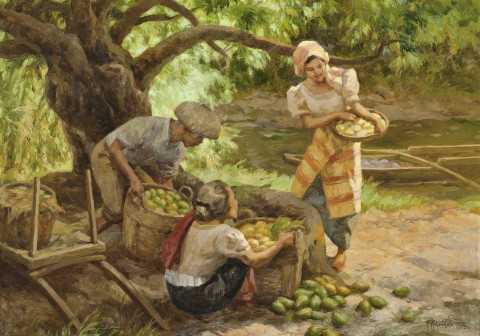GATHERING MANGOES, 1965
FERNANDO CUETO AMORSOLO
oil on canvas
61.0 x 86.5 cm
signed and dated lower right: F AMORSOLO 1965
Private collection, Canberra, acquired in Manila, c.1965
Thence by descent
Private collection, Canberra
Four days after his death in 1972, Fernando Amorsolo was honoured with the title ‘The First National Artist in Painting’, by the then President of the Philippines, Ferdinand Marcos. The honour was in recognition of his enormous contribution to the cultural fabric of his country and reflected the esteem in which he was held by his countrymen.
Born into an artistic family in 1892, Amorsolo’s earliest efforts – postcards of local scenes sold to tourists – exhibited a flair for nationalistic pride, as well as a sense for commercial potential. Art school, art prizes and accolades followed as the hardworking Amorsolo gained wider recognition. Patronage also followed and, on a scholarship to Madrid, he encountered firsthand the work of artists such as Goya, Velázquez, Manet and Renoir. When not studying the masters in the Museo del Prado he documented local street life and these encounters had a profound and lasting influence on his work.
Through the 1920s and 30s, now back in the Philippines, the artist’s prodigious output and the popularity of his bucolic and idyllic local subject matter ensured that his reputation continued to grow. Amorsolo’s painting also became extremely popular with visiting diplomats and dignitaries and many of his works have found their way to all corners of the globe.
This image of a peaceful Eden was shattered with the onset of World War Two and the subsequent Japanese occupation of the Philippines. Amorsolo’s observations of his occupied homeland provided a bold, new, but dark subject, the works he created casting him as a heroic and patriotic artist. His images of Filipino men defending the honour of local, peasant women against the Japanese, struck a fiercely defiant chord in the hearts and minds of his countrymen, and further cemented his reputation.
Following the war, Amorsolo returned to the subject which would occupy him for the rest of life; languid rural scenes depicting workers farming the rich soil and celebrating the fruits their land delivers. Our current example, Gathering Mangoes, 1965, is typical of Amorsolo’s most popular works in which depictions of summer’s mellow fruitfulness combine with the artist’s warm colour harmonies to deliver a lush celebration of local life and nature.
HENRY MULHOLLAND
